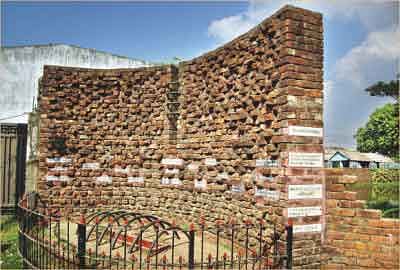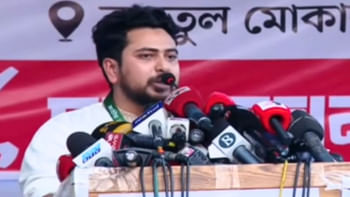Grabbers' eye on war-time killing fields, mass graves

A dilapidated memorial at Modhyam Nath Para of Halishahar in the port city. Photo: STAR
Though 40 years have elapsed, the country is yet to preserve its war time killing fields, mass graves and the torture cells in the port city that bear the testimonies of cruelty and tortures on Bangalees by the Pakistani occupation forces and their local collaborators in 1971.
Many memorial places of these kinds have been damaged due to lack of proper measures or management and negligence by the successive governments and the authorities concerned.
Freedom fighters and relatives of the martyrs have blamed the lack of initiatives of the governments for preserving the historic places of the War of Liberation.
They said the evidences should be preserved to disseminate the true history of the struggle of freedom of the country among the future generations. They demanded the present government preserve the places on priority basis.
The mass graves and memorial sites of 1971 are gradually being grabbed for lack of support and proper direction from the government, they said.
The persons, who are involved in research on the War of Liberation, told The Daily Star that of 114 war-time killing grounds, 46 have already been grabbed by unscrupulous people.
Sixty-eight sites have been lying uncared for and are gradually being grabbed. Of them, 19 are situated on government land and 40 on private lands.
Many business organisations, educational institutions and non-government and government organisations constructed buildings on the sites.
The Awami League government, in its last term, took initiatives to preserve the killing fields and torture centres and directives were also given to the district administrations from the Prime Minister's office in this regard, sources said. But the initiative was stopped with the change of the government.
The AL-led grand alliance government with the support of district administration prepared a list of torture centres, memorial places and killing grounds.
Prof Gazi Saleh Uddin of Chittagong University said the list is at final stage.
“We are trying to make the list perfectly. It would be included in the list if anybody gives information about any killing ground or place related with cruelty, torture by the Al Badar, Razakar or Pakistani occupation forces,” said Prof Saleh, convener of the committee to make the list.
Pahartali Badhyabhumi, Circuit House, Halishahar Nath Para, Bimanbandar area, Lalkhan Bazar Highway Plaza and Dalim Hotel were the big killing centres and torture cells during the War of Liberation in the city, he said.
According to a book titled “Muktijuddha and Chittagong Port” published by Chittagong Port Authority (CPA), there are at least seven war-time killing places in the Chittagong port area. They are Bandar Rest House, Bandar Republic Club, Bandar Bhaban, Bandar Balak Uccha Bidyalaya, Kamantila area adjacent to Chittagong Airport, new mooring power house area and bank of river Karnaphuli in jetty area of Chittagong port. The Pakistani occupation forces used the said areas as torture centres where many people and many port employees and officials were killed.
Prof Saleh said they enlisted 111 killing fields in the district. Of them, 34 have been located in city's Agrabad, 21 in Sadar, 12 in Chandgaon and one each in Bayezid, Pahartali and Halishahar areas.
He said of them, five places have been selected for preservation. He said many important and big torture cells and killing grounds like Lalkhan Bazar have already been grabbed through the construction of high rise buildings and markets.
Terming it a matter of disgrace for the nation, Begum Mushtari Shafi, spouse of a martyr, said the governments were not able to preserve the memorial sites in the past 40 years.
“Negligence of the governments and disagreements between the two big parties are the main causes of losing our achievements in the War of Liberation”, she said. The war-time prisons, concentration camps, mass graves and other historical places are preserved by all countries of the world so that the future generation can learn about the history of the country.
Blaming the successive governments as well as the district administration, Dr Mahfuzur Rahman said the reason for not preserving the important places related to the history of the War of Liberation is “bureaucratic complexity”.
Due to lack of preservation, commercial centres have been constructed on many places. Educational institutions are being constructed on a graveyard of Fayez Lake where hundreds of people were slaughtered during the War of Liberation by Biharis, said Dr Mahfuz, a researcher on the War of Liberation.

 For all latest news, follow The Daily Star's Google News channel.
For all latest news, follow The Daily Star's Google News channel. 



Comments